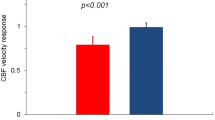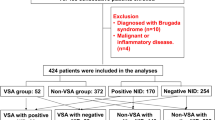Abstract
Purpose
To assess the effects of short-acting nitrates on exercise stress test (EST) results and the relation between EST results and coronary blood flow (CBF) response to nitrates in patients with microvascular angina (MVA).
Methods
We completed 2 symptom/sign limited ESTs on 2 separate days, in a random sequence and in pharmacological washout, in 29 MVA patients and in 24 patients with obstructive coronary artery disease (CAD): one EST was performed without any intervention (control EST, C-EST), and the other after sublingual isosorbide dinitrate, 5 mg (nitrate EST, N-EST). CBF response to nitroglycerin (25 μg) was assessed in the left anterior descending coronary artery by transthoracic Doppler-echocardiography.
Results
At C-EST. ST-segment depression ≥1 mm (STD) was induced in 26 (90 %) and 23 (96 %) MVA and CAD patients, respectively (p = 0.42), whereas at N-EST, STD was induced in 25 (86 %) and 14 (56 %) MVA and CAD patients, respectively (p = 0.01). Time and rate pressure product at 1 mm STD increased during N-EST, compared to C-EST, in CAD patients (475 ± 115 vs. 365 ± 146 s, p < 0.001; and 23511 ± 4352 vs. 20583 ± 6234 bpm⋅mmHg, respectively, p = 0.01), but not in MVA patients (308 ± 160 vs. 284 ± 136 s; p = 0.19; and 21290 ± 5438 vs. 20818 ± 4286 bpm⋅mmHg, respectively, p = 0.35). In MVA patients, a significant correlation was found between heart rate at STD during N-EST and CBF response to nitroglycerin (r = 0.40, p = 0.04).
Conclusions
Short-acting nitrates improve EST results in CAD, but not in MVA patients. In MVA patients a lower nitrate-dependent coronary microvascular dilation may contribute to the lack of effects of nitrates on EST results.

Similar content being viewed by others
References
Bugiardini R, Bairey Merz CN. Angina with “normal” coronary arteries: a changing philosophy. JAMA. 2005;293:477–84.
Erbel R, Ge J, Bockisch A, et al. Value of intracoronary ultrasound and Doppler in the differentiation of angiographically normal coronary arteries: a prospective study in patients with angina pectoris. Eur Heart J. 1996;17:880–9.
Cannon RO, Epstein SE. “Microvascular angina” as a cause of chest pain with angiographically normal coronary arteries. Am J Cardiol. 1988;61:1338–43.
Lanza GA. Cardiac syndrome X: a critical overview and future perspectives. Heart. 2007;93:159–66.
Wessel TR, Arant CB, McGorray SP, et al. NHLBI Women’s Ischemia Syndrome Evaluation (WISE). Coronary microvascular reactivity is only partially predicted by atherosclerosis risk factors or coronary artery disease in women evaluated for suspected ischemia: results from the NHLBI Women’s Ischemia Syndrome Evaluation (WISE). Clin Cardiol. 2007;30:69–74.
Radice M, Giudici V, Marinelli G. Long-term follow-up in patients with positive exercise test and angiographically normal coronary arteries (syndrome X). Am J Cardiol. 1995;75:620–1.
Lanza GA, Crea F. Primary coronary microvascular dysfunction: clinical presentation, pathophysiology, and management. Circulation. 2010;121:2317–25.
Herrmann J, Kaski JC, Lerman A. Coronary microvascular dysfunction in the clinical setting: from mystery to reality. Eur Heart J 2012. [Epub ahead of print]
Neill WA, Judkins MP, Dhindsa DS, Metcalfe J, Kassebaum G, Kloster FE. Clinically suspect ischemic heart disease not corroborated by demonstrable coronary artery disease. Physiologic investigations and clinical course. Am J Cardiol. 1972;29:171–9.
Gavrielides S, Kaski JC, Galassi AR, et al. Recovery-phase patterns of ST segment depression in the heart rate domain cannot distinguish between anginal patients with coronary artery disease and patients with syndrome X. Am Heart J. 1991;122:1593–8.
Lanza GA, Manzoli A, Bia E, Crea F, Maseri A. Acute effects of nitrates on exercise testing in patients with syndrome X. Clinical and pathophysiological implications. Circulation. 1994;90:2695–700.
Radice M, Giudici V, Albertini A, Mannarini A. Usefulness of changes in exercise tolerance induced by nitroglycerin in identifying patients with syndrome X. Am Heart J. 1994;127:531–5.
Kaski JC. Valenzuela Garcia LF, Therapeutic options for the management of patients with cardiac syndrome X. Eur Heart J. 2001;22:283–93.
Galiuto L, Sestito A, Barchetta S, et al. Noninvasive evaluation of flow reserve in the left anterior descending coronary artery in patients with cardiac syndrome X. Am J Cardiol. 2007;99:1378–83.
Voci P, Pizzuto F, Mariano E, Puddu PE, Sardella G, Romeo F. Usefulness of coronary flow reserve measured by transthoracic coronary Doppler ultrasound to detect severe left anterior descending coronary artery stenosis. Am J Cardiol. 2003;92:1320–4.
Hozumi T, Yoshida K, Akasaka T, et al. Noninvasive assessment of coronary flow velocity and coronary flow velocity reserve in the left anterior descending coronary artery by Doppler echocardiography. Comparison with invasive technique. J Am Coll Cardiol. 1998;32:1251–9.
Harrison DG, Bates JN. The nitrovasodilators: new ideas about old drugs. Circulation. 1993;87:1461–7.
Kurz MA, Lamping KG, Bates JN, Eastham CL, Marcus ML, Harrison DG. Mechanisms responsible for the heterogeneous coronary microvascular response to nitroglycerin. Circ Res. 1991;68:847–55.
Chirkov YY, Holmes AS, Chirkova LP, Horowitz JD. Nitrate resistance in platelets from patients with stable angina pectoris. Circulation. 1999;100:129–34.
Rajendran S, Chirkov YY. Platelet hyperaggregability: impaired responsiveness to nitric oxide (“platelet NO resistance”) as a therapeutic target. Cardiovasc Drugs Ther. 2008;22:193–203.
Schächinger V, Britten MB, Zeiher AM. Prognostic impact of coronary vasodilator dysfunction on adverse long-term outcome of coronary heart disease. Circulation. 2000;101:1899–906.
Bugiardini R, Borghi A, Pozzati A, Ottani F, Morgagni GL, Puddu P. The paradox of nitrates in patients with angina pectoris and angiographically normal coronary arteries. Am J Cardiol. 1993;72:343–7.
Lanza GA, Colonna G, Pasceri V, Maseri A. Atenolol versus amlodipine versus isosorbide5-mononitrate on anginal symptoms in syndrome X. Am J Cardiol. 1999;84:854–6.
Author information
Authors and Affiliations
Corresponding author
Rights and permissions
About this article
Cite this article
Russo, G., Di Franco, A., Lamendola, P. et al. Lack of Effect of Nitrates on Exercise Stress Test Results in Patients with Microvascular Angina. Cardiovasc Drugs Ther 27, 229–234 (2013). https://doi.org/10.1007/s10557-013-6439-z
Published:
Issue Date:
DOI: https://doi.org/10.1007/s10557-013-6439-z




